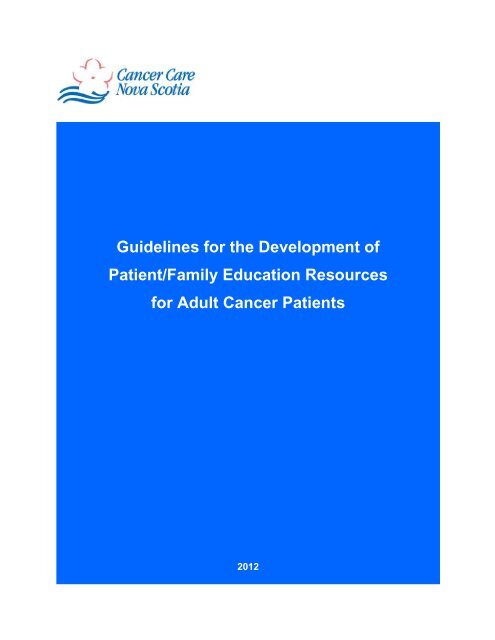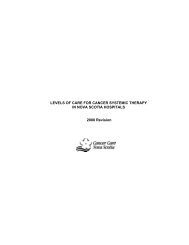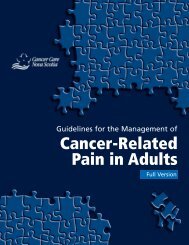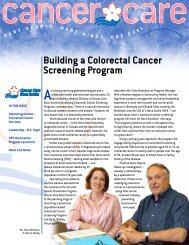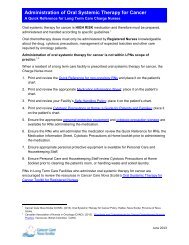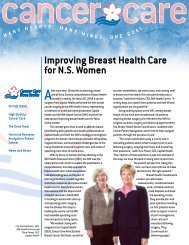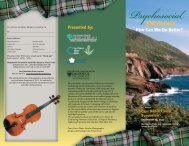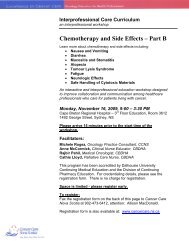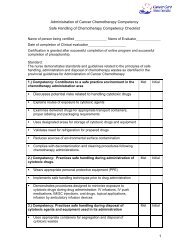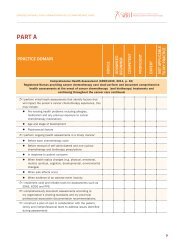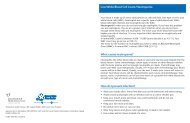Download - Cancer Care Nova Scotia
Download - Cancer Care Nova Scotia
Download - Cancer Care Nova Scotia
Create successful ePaper yourself
Turn your PDF publications into a flip-book with our unique Google optimized e-Paper software.
Guidelines for the Development of<br />
Patient/Family Education Resources<br />
for Adult <strong>Cancer</strong> Patients<br />
2012
Table of Contents<br />
Forward ............................................................................................................................ I<br />
Introduction ..................................................................................................................... 1<br />
Scope and Purpose .................................................................................................. 1<br />
Assumptions ............................................................................................................. 2<br />
Selecting/Creating Quality Patient/Family Education Resources ...................................... 3<br />
Health Literacy .......................................................................................................... 3<br />
Table 1 Learning Preferences ....................................................................... 4<br />
The Selection/Development Process ........................................................................ 5<br />
Figure 1 Patient Education Resource Development Process Flowchart .......... 8<br />
Updating Resources ............................................................................................... 12<br />
Implementing New Resources ................................................................................ 13<br />
Guidelines for the Clinical Department/Group Developing the Resource ....................... 14<br />
Organization ........................................................................................................... 14<br />
Style & Language ................................................................................................... 14<br />
Illustrations ............................................................................................................. 15<br />
Readability .............................................................................................................. 17<br />
Visual Appearance .................................................................................................. 18<br />
Translation .............................................................................................................. 18<br />
General Hints .......................................................................................................... 19<br />
Additional Information regarding Video/Multimedia Resources .............................. 20<br />
Guidelines for the Graphic Designer formatting the Resource ........................................ 21<br />
Visual Appearance .................................................................................................. 21<br />
General ................................................................................................................... 21<br />
Guidelines for the Health Professionals using the Resource .......................................... 23<br />
Patient Education Approaches ............................................................................... 24<br />
Figure 2 Teach Back Method ....................................................................... 24<br />
Ordering Resources................................................................................................ 26<br />
Displaying Resources ............................................................................................. 27
Appendices<br />
I SMOG Readability Formula ............................................................................. 28<br />
II Flesch Kincaid Reading Level .......................................................................... 29<br />
III Selecting a Simpler Word ................................................................................ 30<br />
IV Checklist for Developer .................................................................................... 34<br />
V Field Test Evaluation of a Patient Education Resource .................................. 36<br />
References……………………………………………………………………… ……………...39
Forward<br />
The best form of health education is always a purposeful conversation between the Patient<br />
and the Health Professional. Print and multimedia resources are tools to support this<br />
education. When used effectively, print/multimedia resources can assist health care<br />
professionals to maximize limited teaching time and enable patients to better manage their<br />
health. The provision of educational information is considered to be a fundamental<br />
prerequisite of consumer participation in health care. 1,2,3<br />
The Guidelines for the Development of Patient/Family Education Resources for Adult<br />
<strong>Cancer</strong> Patients were created to support the selection and development of effective,<br />
evidence based, culturally sensitive patient/family education resources. <strong>Cancer</strong> <strong>Care</strong> <strong>Nova</strong><br />
<strong>Scotia</strong>’s Education Standards for Adults Affected by <strong>Cancer</strong> 2 form the foundation of these<br />
guidelines.<br />
If you have suggestions to improve these guidelines or have questions, please contact Brian<br />
Taylor, Project Officer - Education, <strong>Cancer</strong> <strong>Care</strong> <strong>Nova</strong> <strong>Scotia</strong>.<br />
Adapted from:<br />
Developers:<br />
Patient/Family Education Print Material Guidelines. (2007). Queen Elizabeth II<br />
Health Sciences Centre, Capital District Health Authority, Halifax, <strong>Nova</strong> <strong>Scotia</strong>. 1<br />
Meg McCallum, Provincial Manager, Education & Patient Navigation, <strong>Cancer</strong><br />
<strong>Care</strong> <strong>Nova</strong> <strong>Scotia</strong><br />
Penny Logan, Manager, Library Services, Capital District Health Authority<br />
Donna Smith, Diverse Communities <strong>Cancer</strong> Coordinator, <strong>Cancer</strong> <strong>Care</strong> <strong>Nova</strong><br />
<strong>Scotia</strong><br />
Contact Person: Brian Taylor, Project Officer - Education, <strong>Cancer</strong> <strong>Care</strong> <strong>Nova</strong> <strong>Scotia</strong><br />
Phone: (902) 473-5106 ; Fax: (902) 473-6412<br />
Email: BrianX.Taylor@ccns.nshealth.ca<br />
Approved by: <strong>Nova</strong> <strong>Scotia</strong> <strong>Cancer</strong> Patient Education Committee, May 15, 2012<br />
Review date: This document will be re-evaluated and revised in September 2014.<br />
Recommended Citation:<br />
<strong>Cancer</strong> <strong>Care</strong> <strong>Nova</strong> <strong>Scotia</strong>. (2012). Guidelines for the Development of<br />
Patient/Family Education Resources. © Crown copyright, Province of <strong>Nova</strong><br />
<strong>Scotia</strong>.<br />
May be reprinted with permission from <strong>Cancer</strong> <strong>Care</strong> <strong>Nova</strong> <strong>Scotia</strong>.<br />
I
Introduction<br />
<strong>Cancer</strong> is a leading cause of morbidity and mortality in Canada. <strong>Nova</strong> <strong>Scotia</strong> has high<br />
cancer incidence and mortality rates amongst both males and females compared to the<br />
national rates 4 . Given the complex nature of the disease, the cancer care system and<br />
treatment modalities, those diagnosed with cancer and their family members will experience<br />
a variety of informational/educational needs throughout their cancer journey. 3,5,6,7<br />
The <strong>Nova</strong> <strong>Scotia</strong> <strong>Cancer</strong> Patient Education Committee (NSCPEC) is a collaborative effort of<br />
<strong>Cancer</strong> <strong>Care</strong> <strong>Nova</strong> <strong>Scotia</strong> (CCNS), the Capital Health <strong>Cancer</strong> <strong>Care</strong> Program, the Cape<br />
Breton <strong>Cancer</strong> Centre and the province’s District Health Authorities (DHAs). Membership is<br />
multidisciplinary; inclusive of experts in oncology practice and patients and family members.<br />
The mandate of the committee is to ensure every adult cancer patient receives excellent,<br />
evidence-based, consistent and timely education in an appropriate format and setting. 8 This<br />
mandate is achieved by establishing and maintaining processes related to patient<br />
education. Patient education is provided to cancer patients and families by health<br />
professionals throughout <strong>Nova</strong> <strong>Scotia</strong>.<br />
Several qualitative studies commissioned by CCNS highlight the variety of information<br />
needs and preferences amongst people affected by cancer as well as the inconsistent,<br />
incomplete and, on occasion, insensitive approaches of health professionals attempting to<br />
address these needs. 9,10,11,12 The 2007 Ambulatory Oncology Patient Satisfaction Survey<br />
identified specific education, information and communication needs as “top priority” because<br />
improvements in these areas would have the greatest impact on overall patient<br />
satisfaction. 13<br />
Scope and Purpose<br />
CCNS envisions a system where cancer patients throughout <strong>Nova</strong> <strong>Scotia</strong> receive excellent,<br />
evidence-based, consistent and timely education concerning their cancer journey in an<br />
appropriate format and setting. 8 These guidelines have been written to assist health<br />
professionals and DHAs in achieving this vision.<br />
1
The scope and purpose of this document is to:<br />
Establish guidelines for health professionals to support professional practice as it<br />
relates to the development of information materials for adults affected by cancer.<br />
Establish guidelines which improve and maintain high quality education for adults<br />
affected by cancer.<br />
Ensure educational resources are available to meet the needs of a diverse<br />
population, reflecting language, literacy, culture and ethnicity, gender, sexual<br />
orientation, age/stage of life, and physical or intellectual abilities.<br />
Assumptions<br />
These guidelines were written with the following assumptions:<br />
The CCNS Education Standards for Adults Affected by <strong>Cancer</strong> 2 ground the<br />
selection/development of educational materials.<br />
The guidelines apply to all channels of information: print, web-based, videotape,<br />
audiotape and slide/multimedia presentations.<br />
Person affected by cancer is inclusive of the person with cancer and their family.<br />
Person refers to an adult.<br />
Family is defined by the person with cancer.<br />
2
Selecting/Creating Quality Patient/Family Education<br />
Resources<br />
The need for quality patient/family education has become greater due to the acuity of the<br />
patient population, increasing complexity of care, shorter hospital stays and a shift towards<br />
outpatient care. Resource materials can be valuable tools for patient education but they are<br />
only supplements and never a substitute for verbal communication. Resource materials can<br />
convey basic repetitive information freeing the Health <strong>Care</strong> Professional to concentrate on<br />
individualized follow-up instruction. They can also enable consistency in teaching by a<br />
diverse group of health professionals. 1,2,3,5,6,7<br />
Health Literacy<br />
Health literacy is the ability to obtain, process, and understand health information to<br />
make informed decisions about health care.<br />
Limited literacy is a widespread but often hidden problem. The ABC Canada Literacy<br />
Foundation Report Summary notes that 48% of Canadian adults age 16 and over have low<br />
literacy. This has not changed since 1994. More than 80% of Canadians over 65, the<br />
biggest users of health care, have low literacy. Those with the lowest literacy are more<br />
likely to have the poorest health status. 14, 15 These facts must be given consideration when<br />
we evaluate and prepare print material for our patients and their families. It should be noted<br />
that most people read at least two grade levels below their last school grade completed, so<br />
relying on the length of formal education as an assessment parameter is a serious<br />
limitation. 15, 16,17,18 A great deal of available patient/family education material is highly<br />
technical, is written at the high school or university level, and as a result often fails to<br />
accomplish the goal of providing understandable material. 14,15,16,17,18<br />
A readability formula should be used to predict the level of reading skills needed to read the<br />
resource. The target grade level of our patient/family education print material at grade six or<br />
below. 18 Computer software programs are available to assist us but they also give only an<br />
estimate of readability. 1<br />
3
A low reading level is only one of many elements that make a piece of material easy to<br />
understand. If patients are to benefit from printed health information, the materials must be<br />
written clearly and concisely. Clear writing includes logical organization and familiar<br />
language, which sounds like every-day speech. Other topics to be considered when<br />
preparing and evaluating the readability of material is the overall appearance, sentence<br />
length and tone.<br />
1,17,18,19, 20,21,22,23,24,25,26,27,28,29<br />
Some health care providers may be concerned that plain language will offend patients who<br />
read well. This has been proven to be a misconception. Skilled readers are not insulted by<br />
clear, concise writing that is designed to meet their needs. Plain language enables them to<br />
quickly read and immediately put to use essential health information. 19 Even highly educated<br />
adults are not insulted by health material written in plain language. 14,15,16<br />
The Canadian Health Literacy Study asked patients who were identified as being “hard-toreach”,<br />
by virtue of language or anxiety, about their preferred ways to learn (patients could<br />
chose more than one option thus the total in Table 1 exceeds 100%). 32<br />
Table 1. Learning Preferences 32 94%<br />
Learning in a group with<br />
other patients<br />
65%<br />
Reading<br />
66%<br />
Watching videos<br />
70%<br />
Learning one-to-one with a<br />
health professional<br />
85%<br />
Verbal explanations from a<br />
healthcare professional<br />
0% 10% 20% 30% 40% 50% 60% 70% 80% 90% 100%<br />
According to the Canadian Council on Learning, the populations most likely to have low<br />
literacy levels are those being asked to manage their conditions - older adults, ethnic<br />
4
minorities, people with low education and income levels, those who do not have English as<br />
their first language and those with a compromised health status. 15 By exploring the use of<br />
group teaching sessions, with powerpoint presentations and demonstrations, and<br />
multimedia tools like video and the internet, we may be able to reach those who cannot or<br />
1, 28, 29, 30,31<br />
prefer not to use traditional print material.<br />
The Selection/Development Process<br />
Identify and confirm the need for a patient education resource.<br />
Develop a work-group and appoint a leader.<br />
Contact the individual responsible for patient education in your District, if applicable.<br />
Request assistance, if available.<br />
Familiarize your group with the CCNS Education Standards for Adults Affected by<br />
<strong>Cancer</strong> 2 and these guidelines.<br />
Develop a plan following the process (pages 8-11), criteria (pages 14-20) and<br />
checklist (Appendix IV) outlined in these guidelines.<br />
Before you begin to develop a new resource, do some research, find out what other<br />
organizations have created, assess if they are current and evidence based.<br />
Determine if any of these resources are suitable (refer to process, page 8).<br />
o All resources developed by the Canadian Partnership Against <strong>Cancer</strong> (CPAC),<br />
Canadian <strong>Cancer</strong> Society (CCS), Canadian Association of Nurses in Oncology<br />
(CANO) and Canadian Association of Psychosocial Oncology (CAPO) are<br />
automatically approved for use in <strong>Nova</strong> <strong>Scotia</strong>. Begin the process at step **<br />
(page 11).<br />
o Resources developed by all other groups are to be reviewed by an Oncology<br />
Site team and the <strong>Nova</strong> <strong>Scotia</strong> <strong>Cancer</strong> Patient Education Committee Materials<br />
Working Group. Begin the process at step * (page 10).<br />
5
The Selection/Development Process, continued<br />
A critical step in the process is field testing the resource with patients from your<br />
25, 33<br />
target audience.<br />
o Testing with five patients is considered sufficient. 34<br />
o Use the form in Appendix V to capture patients’ feedback; first tailor the form to<br />
the nature of your resource.<br />
o You can conduct a focus group, interview patients individually or have them<br />
complete the form themselves.<br />
o Some researchers believe it is best to conduct the field test in the same type of<br />
environment in which the patient will be using the resource. 33 For example, if a<br />
patient will be reading a factsheet in a noisy, busy clinic, be sure that test<br />
readers have the same distractions.<br />
o The goal of the field test is to determine if your patients can:<br />
• Understand the information, the words and the concepts.<br />
- Do readers understand the term “safe handling”? Or, do they<br />
understand a concept like “dressing check”, ask who checks and<br />
what are they looking for? The words may be easy but the concept<br />
may not be clear.<br />
• Find the information they need.<br />
- Ask your patients questions from the resource. Have them search<br />
the resource; they should be easily able to find the answers to your<br />
questions. For example, when can you lift heavy objects after your<br />
surgery? When can you drive your car?<br />
• Act on instructions.<br />
- If the resource says “If you have a fever, call your doctor.” Ask the<br />
patients what is considered a fever? Which doctor should they call?<br />
Do they have the phone numbers they need?<br />
6
The Selection/Development Process, continued<br />
o The goal of the field test is to determine if your patients can:<br />
• Understand the graphics.<br />
- Ask the patients to describe the images and ask them if they find<br />
them helpful. Pretesting visuals with your target audience ensures<br />
25, 33<br />
your message is clear and culturally acceptable.<br />
• Follow the sequence of the information.<br />
- A great strategy to determine if you have sequenced the<br />
information properly is to cut up your document into sections and<br />
ask your patients to put it together like a puzzle. This reveals how<br />
they believe the information should flow. 25<br />
7
Figure 1 Patient Education Resource Development Process Flowchart<br />
Development, Revision and Approval Procedure<br />
Who is Responsible?<br />
Need for Patient Education resources identified<br />
Developer<br />
Locate existing material<br />
Developer<br />
Critique material using Check List for Developer (App IV)<br />
Developer<br />
Go to step*of process<br />
Yes<br />
Pamphlet Meets Criteria<br />
Developer<br />
Minor Revision<br />
No<br />
Major Revision<br />
Establish work-group<br />
Developer<br />
Familiarize work group with Patient\Family Education Print<br />
Material Guidelines and Patient Education Standards<br />
Developer<br />
Contact, the Project Officer, Education (CCNS) to avoid duplication of<br />
efforts and increase awareness of resources.<br />
Developer<br />
8
Development, Revision and Approval Procedure, cont<br />
Who is Responsible ?<br />
Consult with the appropriate resource people ( including other<br />
disciplines) throughout the development process as required.<br />
Developer<br />
Prepare electronic draft of text, using checklist for developer (App IV)<br />
Developer<br />
Obtain and document clinical approval from appropriate stakeholders<br />
Developer<br />
Obtain feedback from someone who is unfamiliar with content area and<br />
adjust if needed.<br />
Developer<br />
Rewrite and<br />
reevaluate<br />
No<br />
Pamphlet<br />
Satisfactory<br />
Developer<br />
Yes<br />
Field test the draft to ensure the product works using Field Test<br />
Evaluation of Patient Education Resources form (App V)<br />
Developer<br />
No<br />
Rewrite and<br />
reevaluate<br />
Pamphlet<br />
Satisfactory<br />
Developer<br />
Yes<br />
9
Development, Revision and Approval Procedure, cont<br />
Who is responsible<br />
Step *<br />
Submit final electronic draft to CCNS Project Officer - Education (CCNS) for<br />
consideration of NSCPEC and relevant site teams<br />
Developer<br />
NSCPEC Materials Working Group evaluates<br />
resources as a teaching tool<br />
Site Team evaluates resource for<br />
clinical accuracy<br />
CCNS Project Officer<br />
Recommend adjustments<br />
to developer<br />
No<br />
Resource Meets Criteria<br />
CCNS Project Officer<br />
Yes<br />
Is this an existing<br />
resource?<br />
Yes<br />
Move to<br />
step **<br />
CCNS Project Officer<br />
No<br />
CCNS Project Officer<br />
Alert developer of NSCPEC and site team recommendation<br />
CCNS Project Officer<br />
Consult with Graphic Designer if illustrations are needed<br />
Collaborate with the graphic designer<br />
CCNS project officer sends Email to Graphic Artist (AV), Print Shop and Web<br />
team to notify them of the changes(s)<br />
Graphic Artist does the following – Updates Catalogue<br />
– Sends “approved’ pamphlet to print shop<br />
(within 7 days)<br />
Web team updates the Online version of the Teaching<br />
Pamphlets Order Numbers Catalogue at the following URL:<br />
http//cdhaintra.cdha.nshealth.ca/pamphletcatalogue/indexhtml<br />
Graphic Designer/ Print Shop<br />
3<br />
10
Development, Revision and Approval Procedure, cont<br />
Who is Responsible?<br />
Print shop adds, exchanges or deletes proof as appropritate<br />
Proof resources to Project Officer<br />
CCNS Project Officer<br />
Final approval following consultation with developer<br />
CCNS Project Officer<br />
Step **<br />
Notify NSCPEC when the resource is available.<br />
CCNS Project Officer<br />
Send samples of pamphlet and order instructions to the Manager of Satellite clinics,<br />
Directors of <strong>Cancer</strong> Centers, Capital Health Patient Education Coordinator and<br />
Patient Navigators<br />
Chair, NSCPEC<br />
Maintain a record: resource title number, development or revision date and<br />
owner (unit or department)<br />
CCNS Project Officer<br />
Ensure pamphlet is placed on CCNS website<br />
CCNS - Communications Assistant<br />
Review and ensure resource is updated every 3 years, or more<br />
frequently if necessary.<br />
CCNS Project Officer<br />
11
Updating Resources<br />
All patient/family education resources are to be reviewed every 3 years.<br />
o For web-based information, changes in clinical practice or contact numbers<br />
need not wait for the regular review cycle, these updates should be made by<br />
the developer as soon as possible.<br />
The CCNS Project Officer will notify the developer when a pamphlet needs to be<br />
evaluated, in January of the year it is to be reviewed.<br />
A second notice will be sent in April if the Developer has not responded.<br />
On December 31st of that year, the CCNS Project Officer will remove the resource<br />
from circulation if there has not been any response from the Developer.<br />
The clinical department/group which developed the resource will review and update<br />
the resource considering:<br />
Changes in evidence/clinical practice.<br />
Changes in contact numbers/persons.<br />
Changes in pre or post instructions.<br />
Changes in drugs or dosages.<br />
Changes in equipment the patient uses.<br />
Feedback regarding the effectiveness of the resource:<br />
o Do patients appear to be confused by the information?<br />
o Are they using the resource?<br />
o Are patients following the instructions provided?<br />
o Is there a change in the number of cancellations or complications?<br />
Implementing New Resources<br />
12
When developing or revising resources, it is critical to consider an implementation plan.<br />
Patient Education resources are effective only when used as a part of an overall patient<br />
education strategy. Simply handing your patient a pamphlet or a DVD or directing them to<br />
an online resource is not enough to promote understanding or behaviour change. 2 *<br />
Questions to consider when developing your implementation plan:<br />
How does this resource fit into the overall patient education approaches for this<br />
patient population?<br />
Will Health Professionals require additional training to use the resource?<br />
How will you communicate the availability of the resource to health professionals,<br />
patients and families?<br />
If the new resource replaces another resource currently in use, how will you get the<br />
outdated resources out of the system?<br />
How will you evaluate if the resource is effective?<br />
For additional implementation considerations, refer to the Guidelines for Health <strong>Care</strong><br />
Professionals using the Resource on pages 24-28.<br />
Guidelines for the Clinical Department/Group<br />
1,17,18, 21,22,23,25,26,27,28,29, 32,33<br />
Selecting/Developing the Resource<br />
* For further information about comprehensive approaches to patient education, refer to Education<br />
Standards for Adults Affected by <strong>Cancer</strong> and Patient Education Fundamentals © Crown copyright,<br />
Province of <strong>Nova</strong> <strong>Scotia</strong>, 2011, available via <strong>Cancer</strong> <strong>Care</strong> <strong>Nova</strong> <strong>Scotia</strong> or visit<br />
http://www.nchealthliteracy.org or access the American Medical Association Health literacy and patient<br />
safety. Manual for clinicians .<br />
13
Organization<br />
Title reflects content.<br />
The opening paragraph states the purpose of the pamphlet.<br />
Question & Answer format is useful.<br />
Headings and subheadings are required.<br />
A glossary is important and should be placed at the beginning rather than at the<br />
end of a pamphlet so the reader is more likely to find and use it.<br />
A table of contents is not necessary if the pamphlet is less than 8 pages in length.<br />
Style & Language<br />
Use a friendly tone. A conversational style has a more natural tone and is easier to<br />
read and understand. Read your material aloud to see how it sounds.<br />
Write in an active voice. For example, take your medication after meals rather<br />
than, your medication should be taken after meals.<br />
Promote the patient taking an active role in their health.<br />
Talk directly to the reader. Use the words: you, I, we, us and our to make the<br />
material more personal. Do not refer to your readers as clients or patients.<br />
Include quotes from patients/family members that reflect their experience.<br />
Use gender free language.<br />
Be sensitive to the cultural values and beliefs of diverse communities.<br />
Place the subject and verb close to the beginning of the sentence.<br />
Eliminate all unnecessary words.<br />
Use 1 or 2 syllable words as much as possible.<br />
Style & Language, continued<br />
14
Maintain average sentence length of 10 words or less.<br />
Limit paragraphs to 4 or 5 sentences.<br />
List information whenever possible, focus on the “need to know” rather than the<br />
“nice to know” information.<br />
Emphasize important information.<br />
When using abbreviations and acronyms give them first and spell the word in<br />
parentheses; e.g., after your surgery you may stay in ICU (Intensive <strong>Care</strong> Unit).<br />
Be consistent with word use. Choose the most familiar words and use them<br />
throughout. For example, Vincristine and Oncovin may be the same thing to you,<br />
but your reader may think they are two different drugs.<br />
Use analogies familiar to your audience. Say: Feel for lumps the size of a pea.<br />
Instead of: Feel for lumps about 5 to 6 mm in diameter.<br />
Instead of using statistics, use general words like most, many, or half. If you must<br />
use statistics, try putting them in parentheses.<br />
Illustrations<br />
Consult with the graphic designer in the Audio Visual Department regarding<br />
illustrations. Limited clip art is available from the designer.<br />
Use illustrations that are copyright free or obtain written permission to use from<br />
owner. Submit copyright permission with draft of text to CCNS.<br />
Use simple line drawings.<br />
Use adult rather than child-like images.<br />
When using line drawings of anatomy, include body landmarks.<br />
Ensure that illustrations are up-to-date.<br />
Illustrations, continued<br />
15
Label diagrams with familiar words.<br />
If using colours, be aware that some people cannot tell red from green and printing<br />
in colour increases your cost. Resources don’t have to be in colour to be effective.<br />
Use pictures and photos with concise captions; keep captions close to graphics.<br />
Present one message per visual.<br />
Create visuals that help to emphasize or explain the text. Avoid visuals that<br />
decorate your materials or are very abstract. Note: not all audiences understand<br />
cartoons or take them seriously.<br />
When showing internal body parts, include the outside of the body to aid viewer<br />
understanding. Avoid cutting off body parts.<br />
Use images showing actions you want readers to take. Avoid images that show<br />
what the reader should not do.<br />
To prevent patients from mistaking a "Do Not" drawing for a "Do", use the familiar<br />
heavy slash through the diagram.<br />
Avoid graphs/charts unless they really help readers to understand the material.<br />
Try to include pictures that represent various ethnic groups, both men and women<br />
equally and avoid stereotypical occupational roles.<br />
Balance the use of text, graphics, and clear “white” space. In general: leave at least<br />
0.5 to 1 inch of white around the margins of the page and between columns.<br />
If medication information is included, consider adding pictograms.<br />
o The USP Pictograms are standardized graphic images that help convey<br />
medication instructions, precautions, and/or warnings to patients and<br />
consumers. You can download the pictogram library from<br />
www.usp.org/audiences/consumers/pictograms. 35<br />
Readability<br />
16
Target the reading level to grade six or below.<br />
o Use a readability formula - SMOG 36 and Flesch – Kincaid 37 are good<br />
choices (refer to Appendix I & II for more detail).<br />
o A variety of readability scores can be compared at a glance by pasting text<br />
from a WORD document into the readability calculator found at:<br />
http://www.wordscount.info/index.html<br />
Unless it is necessary for the reader to learn medical words, always use plain<br />
language (refer to Appendix III).<br />
When used, define medical terms.<br />
Use dark type (navy or black) on white or cream background.<br />
Avoid glossy paper.<br />
Do not use Roman numerals.<br />
Do not use abbreviations.<br />
Do not hyphenate words over two lines.<br />
Focus on “need to know” information. Limit number of messages; present readers<br />
with no more than three or four main ideas per document or document section.<br />
Clearly state the actions readers are to take.<br />
Don’t include details that are irrelevant to the reader’s healthcare needs. For<br />
example, if you are writing about how to prevent Skin <strong>Cancer</strong>, you don’t need to tell<br />
readers how and when skin cancer was first discovered.<br />
Stick to one idea at a time; skipping back and forth between topics can be<br />
confusing.<br />
Avoid lengthy lists. Limit lists to five or six items. If some items are more important<br />
than others, list them in order of priority.<br />
Visual Appearance<br />
17
Do not use all upper case letters.<br />
Limit the use of italics.<br />
Do not use different type faces on the same page.<br />
Use a font between 11 - 14 point sizes in the body text.<br />
Use Adobe Georgia or Arial font.<br />
Use a justified left margin and a ragged right margin.<br />
Use generous amounts of white space (areas without print).<br />
Use wide margins and borders.<br />
Use bullets.<br />
Skip at least one line between paragraphs and sections.<br />
Translation<br />
Depending on the diversity of your patient population, you may wish to consider<br />
arranging translation to target patients/families who do not speak English.<br />
Do not use online translation tools and/or computer software. A professional,<br />
certified translator must be used.<br />
Within CDHA, translation will be initiated by the CDHA Patient Education<br />
Coordinator. Other Districts should connect with their Communications Department<br />
to explore translation options.<br />
Rather than translating your resource you may wish to note organizations and<br />
websites where similar information can be found in languages other than English. A<br />
list of such resources can be found at www.cancercare.ns.ca.<br />
General Hints<br />
Be prepared to go through several drafts.<br />
18
Remember your readers' cultural, ethnic, economic and educational backgrounds.<br />
If you are adapting an existing resource, cite the approval to adapt (e.g. Adapted,<br />
with permission, from Nausea, X <strong>Cancer</strong> Agency, 2010).<br />
Develop and maintain a bibliography of sources used in the development of the<br />
pamphlet. Do not include these in the pamphlet.<br />
If there are websites or other resources patients may find helpful, list them at the<br />
end of your resource,<br />
Additional Information regarding Video/Multimedia Resources<br />
In addition to the guidelines noted in previous sections, when selecting/creating<br />
video/multimedia resources, the following guidelines apply.<br />
Content: must be current and consistent with best practice.<br />
o Language used should be simple, everyday conversation with medical<br />
jargon kept to a minimum.<br />
o The title used should reflect the content<br />
o The key take-home message should stand out.<br />
o Choose 2-3 main concepts, goals or messages to focus on.<br />
o All information should be essential, immediately applicable and actionable.<br />
o Offer positive examples of practical behavior changes the learner can<br />
engage in right away, e.g. starting a walking program or eliminating sugary<br />
pop from their diet.<br />
o Different cultures should be portrayed wherever possible.<br />
Additional Information regarding Video/Multimedia Resources<br />
o Patient participation in video development, either directly or indirectly, is<br />
highly recommended.<br />
19
o Hearing from patients in similar situations tends to be reassuring to many<br />
patients and connects them with the video content.<br />
Length: Shorter videos are more appealing to those feeling ill or under stress.<br />
o Recommended: TV - 10 minutes or less; Web - 5 minutes or less.<br />
o If the information cannot be delivered in 5-10 minutes, break it into two or<br />
more parts (eg. Managing Pain – Part 1, Managing Pain, Part 2).<br />
If you are planning to post the video on a hospital TV system, please check with<br />
your District regarding District specific content and placement processes.<br />
For additional helpful hints, review the “Death by PowerPoint” article noted in the<br />
reference list. 38<br />
20
Guidelines for the Graphic Designer formatting the<br />
1,17,18, 21,22,23,25,26,27,28, 33<br />
Resource<br />
Visual Appearance<br />
Do not use all upper case letters.<br />
Limit the use of italics.<br />
Do not use different type faces on the same page.<br />
Use a font between 11 - 14 point sizes in the body text.<br />
Use Adobe Georgia or Arial font.<br />
Use a justified left margin and a ragged right margin.<br />
Use generous amounts of white space (areas without print).<br />
Use wide margins and borders.<br />
Use bullets.<br />
Skip at least one line between paragraphs and sections.<br />
Ensure copyright approval is secured for all illustrations.<br />
Use one of the standard covers.<br />
General<br />
Include the name of the developer with credentials and unit or department (on the<br />
back cover, if in pamphlet format).<br />
The year that the resource is developed / revised is to be placed on the front.<br />
Only the developer can revise / replace a resource. Anyone who identifies that a<br />
resource requires updating is to contact the developer.<br />
Pamphlet size will be 8½ x 11 inch or 8½ x 5½ inch or 8½ x 11 tri-fold.<br />
Page numbers are to be included if it is more than one folded page.<br />
21
General, continued<br />
Include the CCNS and District Health Authority logo on each pamphlet.<br />
Place a Print Shop order number on each pamphlet and ensure that this is<br />
entered into the catalogue.<br />
o If this version replaces another resource, alert the Print Shop so they<br />
discontinue printing of the previous version.<br />
Include the hospital smoking and scent policy on the pamphlet.<br />
Place this disclaimer on the back cover of each resource:<br />
This information is provided for educational purposes only and is not intended to<br />
replace medical advice, the instruction of a healthcare provider, or to substitute for<br />
medical care. If you have any questions about your health and/or your treatment,<br />
please ask your healthcare provider.<br />
Promote the CCS website and HRM Library Services on the back cover of each<br />
pamphlet with the following statements:<br />
Looking for more information?<br />
Visit www.cancer.ca or call 1-888-939-3333<br />
Contact your local public library for books, videos and online health information.<br />
For a list of public libraries in <strong>Nova</strong> <strong>Scotia</strong> go to www.library.ns.ca<br />
22
Guidelines for the Health Professional Using the Resource *<br />
Patient Education Approaches<br />
Patient education plays a major role in empowering patients and families with cancer.<br />
Educating patients about their disease, treatment, side effect management and quality of life<br />
can reduce patient anxiety, enhance coping mechanisms, reduce decisional conflicts,<br />
promote patient autonomy and improve the experience for patients and families. Patients<br />
who understand their disease and treatment have greater compliance with therapy, which<br />
translates into better outcomes. 3<br />
Education is an ongoing process and should be provided in a variety of ways to meet the<br />
individual needs of patients. Formal or informal approaches using individual or group<br />
teaching supported by various teaching strategies such as print material, computer based<br />
education programs, interactive multimedia technology, audiovisual programs and support<br />
groups are widely used. Regardless of the approach used, health professionals must<br />
continuously reinforce learning throughout the provision of care. 40, 41, 42<br />
,<br />
Patient Education resources are effective only when used as a part of an overall patient<br />
education strategy. Simply handing your patient a pamphlet or a DVD or directing them to<br />
an online resource is not enough to promote understanding or behaviour change.<br />
Patient Education resources should be used to facilitate discussion, not replace it. Review<br />
the material with the patient. Make note of important information by circling or highlighting it,<br />
and discuss how it relates to the patient’s care. Consider personalizing the materials by<br />
adding the patient’s name, medications, or specific care instructions.<br />
Researchers estimate that 40-80% of the medical information patients receive is forgotten<br />
immediately and nearly half of the information retained is incorrect. 40,41<br />
* For further information about comprehensive approaches to patient education, refer to Education<br />
Standards for Adults Affected by <strong>Cancer</strong> and Patient Education Fundamentals © Crown copyright, Province<br />
of <strong>Nova</strong> <strong>Scotia</strong>, 2011, available via <strong>Cancer</strong> <strong>Care</strong> <strong>Nova</strong> <strong>Scotia</strong> or visit http://www.nchealthliteracy.org or<br />
access the American Medical Association Health literacy and patient safety. Manual for clinicians .<br />
23
Patient Education Approaches, continued<br />
One of the easiest ways to close the communication gap between the health care<br />
professional and the patient is to use the “teach-back” method, also known as the “showme”<br />
method. Teach-back enables you to confirm that you have explained to the patient what<br />
they need to know in a manner that the patient understands. Patient understanding is<br />
confirmed when they explain it back to you.<br />
42, 43, 45<br />
Figure 2 Teach Back Method 42<br />
Step 1: Using plain language, explain the concept/instruction or demonstrate the<br />
process to the patient.<br />
Step 2: Ask the patient to describe the concept/instruction or demonstrate the process.<br />
Step 3: Identify and correct misunderstandings of or incorrect procedures by the patient.<br />
Step 4: Ask the patient to explain the concept/instruction again or demonstrate the<br />
process to ensure the above-noted misunderstandings are now corrected.<br />
Step 5: Repeat Steps 4 and 5 until you are convinced the patient understands the<br />
concept or has the ability to perform the procedure accurately and safely.<br />
24
Patient Education Approaches, continued<br />
When using "teach-back," health professionals ask patients to state in their own words key<br />
concepts, decisions, or instructions just discussed:<br />
You could begin with statements such as, "I want to make sure I explained this<br />
clearly. When you go home today, what will you tell your [friend or family member]<br />
about [key point just discussed]?" or “Please explain to me how and when you will<br />
take your medications, so I can be sure I explained everything correctly.” Or “What is<br />
your understanding of your treatment plan?”<br />
If patients cannot restate/demonstrate the instructions correctly, then you explain it<br />
again by drawing pictures or using simpler words.<br />
Then the teach-back method is used again and repeated until you confirm that the<br />
key message is correctly understood. If you know you explained this well but after<br />
two or three tries the patient still does not "get it," then look for other explanations<br />
(beyond your teaching) about why the message was not understood. 42,43,45<br />
When summarizing and restating key aspects of what patients are sharing, you might say, "I<br />
just want to make sure that I heard you correctly. When you said [key point], I understood<br />
that to mean [x]…. Is that correct? Is there something I missed?" By doing this, you not only<br />
confirm (or not) that messages are correctly understood but also demonstrate your<br />
commitment to helping patients feel that they've been heard. In addition, this line of<br />
questioning models the teach-back technique so that patients are not surprised when you<br />
ask them to repeat back what you just said. 42,43,45<br />
When using the teach-back technique, health professionals take responsibility for adequate<br />
teaching. If patients cannot explain or demonstrate what they should do, the health<br />
professional must assume that they did not provide an adequate explanation or<br />
understandable instructions and that they must try another approach to ensure that patients<br />
learn what they need to know. 42,43,45<br />
25
Patient Education Approaches, continued<br />
The “teach-back” technique is intended to replace the more common practice of simply<br />
asking a patient, “Do you understand what I have told you?” More often than not patients<br />
will answer “yes” to this question, even when they understand nothing. 42,43,45<br />
The same is true for another question commonly asked by health professionals “Do you<br />
have any questions?” When asked this question, patients are likely to respond “no” even<br />
when they have questions or don’t know where to start with their numerous questions. A<br />
more appropriate approach is offer a statement like – “Most of my patients usually have<br />
questions about [key point just discussed]” and follow by offering the answers to the most<br />
frequently asked questions.<br />
42, 43, 45<br />
Research indicates that the teach-back technique is effective, not just for improving patients’<br />
understanding, but also for improving outcomes. For example, patients with diabetes whose<br />
physicians assess patient’s comprehension and recall with the teach-back technique have<br />
significantly better diabetes control than patients whose physicians do not use the<br />
technique. 42,43,45<br />
Ordering Print Resources<br />
Use the pamphlet number noted in the CDHA catalogue, do not use the number<br />
on the pamphlet itself – if you do, you risk ordering outdated resources.<br />
Use pamphlets printed from a master in the Print Shop. Do not photocopy.<br />
Order limited numbers from the Print Shop. An order can be as small as only 15<br />
copies. This may help to prevent waste as materials are updated regularly.<br />
When a particular topic is rarely addressed, print the relevant resources from the<br />
District, CCNS or another recommended website.<br />
26
Displaying Resources<br />
Assign one staff person to order the pamphlets and maintain the pamphlet racks.<br />
o This person should regularly scan the resources; discarding outdated<br />
materials and replacing them with the most current.<br />
Placing patient information resources in high-traffic areas gives patients and<br />
families ready access to information that is relevant to them.<br />
Display resources in an organized manner so it is easy for the patient to find the<br />
information they need.<br />
27
Appendix I SMOG Readability Formula 36<br />
Patients and their families must be able to read, understand and act upon our instructions.<br />
We must remember that many individuals read at least two grade levels below their last<br />
school grade completed. 17<br />
Target the reading level for grade six or below.<br />
A readability formula enables us to take a rough measure of the reading level of material.<br />
But, it is not a substitute for common sense, as there are other considerations when<br />
preparing material. The fact that an item is written at a low reading level does not mean that<br />
it is clear and well written.<br />
SMOG for Text Containing More Than 30 Sentences:<br />
1. Choose 10 consecutive sentences from near the beginning, middle and end of your text.<br />
Skip titles and headings.<br />
a. If a sentence contains a colon, avoid using that sentence in your count, OR count<br />
it as two sentences.<br />
2. In the sample of 30 sentences, count all words that have 3 or more syllables<br />
a. Verbs ending in "ed" or "es" that give the word a third syllable are not counted.<br />
b. Include repetitions of the same word, no matter how often it is used.<br />
c. Hyphenated words are considered one word.<br />
d. Numbers should be pronounced to determine the number of syllables.<br />
e. Abbreviations should be read as unabbreviated to determine the number of<br />
syllables.<br />
3. Find the nearest square root of this total.<br />
4. Add 3 to the square root to find the reading level.<br />
SMOG Readability Calculator<br />
The SMOG Calculator assesses an entire text, not just a sample. To use the Calculator,<br />
go to: http://www.harrymclaughlin.com/SMOG.htm.<br />
28
Appendix II Flesch – Kincaid Reading Level Assessment<br />
37 *<br />
In Microsoft Office Word 2003 and earlier, go to Tools Options Spelling & Grammar; in<br />
Word 2007, go to Office button Word Options Proofing. In either case, check the box for<br />
"Show readability statistics".<br />
When you check spelling manually by pressing F7, after the check is complete you'll see<br />
a dialog box with statistics, one of which is the Flesch-Kincaid Grade Level.<br />
The Flesch-Kincaid tool rates text on a U.S. school grade level. For example, a score of<br />
8.0 means that a person who has completed grade eight can understand the document.<br />
The formula for the Flesch-Kincaid Grade Level score is:<br />
(.39 x ASL) + (11.8 x ASW) – 15.59<br />
ASL =<br />
average sentence length (the number of words divided by the number of<br />
sentences).<br />
ASW = average number of syllables per word (the number of syllables divided<br />
by the number of words).<br />
29
Appendix III<br />
Writing in Plain Language - Selecting a Simpler<br />
Word 44*<br />
Complex Simple Complex Simple<br />
Abdomen Stomach area Decrease Lessen, reduce<br />
Ability Skill Demonstrate Show, explain<br />
Accompany Go with Detect Find, notice<br />
Accomplish Do, carry out Determine Find out<br />
Acetaminophen e.g., Tylenol ® /Tempra ® Difficulty Problem, trouble<br />
Achilles tendon Heel cord Discolouration Change in colour<br />
Acidosis Too much blood acid Discontinue Stop<br />
Acne Red pimples Discover Learn, find out,<br />
see<br />
Acquire Gain, get Discuss Talk about, speak<br />
with<br />
Adequate Enough Dressing Bandage,<br />
covering<br />
Administer Give Due to the fact that Because<br />
Advise Tell, recommend Effect Result, bring<br />
about<br />
Aggravate Make worse, worsen Elevate Raise, lift (up)<br />
Alternative Choice Eliminate Reduce, remove,<br />
cut out<br />
Ambulate Walk Endeavor Try, attempt<br />
Analgesic Pain reliever Ensure Make sure<br />
Annually Yearly Epidermis Skin<br />
Anticipate Expect Excessive Too much<br />
Appears Seems Experience Feel, have<br />
30
Complex Simple Complex Simple<br />
Apply Put on, use Facilitate Help, aid, assist<br />
Approximately About Failed to Did not<br />
Ascertain Find out Frequently Often<br />
Assist Help Fundamental Basic, important<br />
At the present<br />
time<br />
Now Furthermore Also<br />
Attempt Try Hazardous Unsafe, harmful,<br />
risky<br />
Available Ready Hematoma Bruise<br />
Bacteria Germs However But, yet, still<br />
Benefit Help Ibuprofen e.g. Advil ® ,<br />
Motrin ®<br />
Cessation Stop, pause Identical Same, alike,<br />
equal<br />
Choose Pick Indicate Show<br />
Close proximity Near Impair Harm, make<br />
worse<br />
Commence Begin Implement Carry out<br />
Complete Finish, fill out In addition Also<br />
Comply Do, follow In an effort to To<br />
Components Parts In the event that If<br />
Conclude End, finish In the near future Soon<br />
Consult Ask Inadvisable Unwise<br />
Contraceptive Birth control Incision Cut, opening<br />
Contact Call Incorrect Wrong<br />
31
Complex Simple Complex Simple<br />
Contains Has Indicate Show<br />
Contusion Bruise Indication Sign<br />
Inform Tell Presently Now<br />
Ingest Eat Provide Give, offer<br />
Initial First Provided that If<br />
Interrupt Stop Purchase Buy<br />
Injection Shot, needle Receive Get<br />
Insufficient Not enough Recuperate Get better, get<br />
well<br />
Intention Aim Regarding About<br />
Laceration Cut, tear Rehabilitate Recover, restore<br />
Locate Find Relating to About, on<br />
Location Place Remainder Rest of<br />
Maintain Keep, support Remove Take out<br />
Medication Medicine, pills Request Ask<br />
Minimal Least Require Need<br />
Modify Change, revise, adjust Requires Asks, calls for,<br />
needs<br />
Monitor Check, watch Retain Keep<br />
Negative No, harmful Reveal Show<br />
Notify Tell Review Check, go over<br />
Observe Watch, see, note Ruptured Burst<br />
Obtain Get, find Sensation Feeling<br />
Optimum Best Similar Like<br />
32
Complex Simple Complex Simple<br />
Option Choice Sufficient Enough<br />
Permit Allow, let Sutures Stitches<br />
Persuade Convince Therapy Treatment<br />
Physician Doctor Torn ligament Sprain<br />
Place Put, rest, lay Unnecessary Needless, not<br />
needed<br />
Prior (to) Before, earlier Utilize Use<br />
Present<br />
Give<br />
*<br />
Adapted, with permission, from Guidelines for Developing Printed Health Material, Calgary Health Region,<br />
2005.<br />
33
Appendix IV<br />
Title:<br />
Check List for Developer<br />
Developer:__________________<br />
Date: ________________________<br />
Department:_________________<br />
Clinical Assessment Yes No<br />
Information is current, accurate and evidence based.<br />
Information is aligned with clinical practice guidelines<br />
Information is sufficient for purpose.<br />
Educational Assessment<br />
Maintains interest and attention.<br />
Organization of information is logical.<br />
Technical terms or acronyms are identified.<br />
Reading level is grade 6 or below. If not, note the grade level<br />
Focuses on “need to know” information<br />
Key messages are clear<br />
Adheres to the <strong>Cancer</strong> <strong>Care</strong> <strong>Nova</strong> <strong>Scotia</strong>’s Education Standards for<br />
Adults Affected by <strong>Cancer</strong> (available via www.cancercare.ns.ca).<br />
Technical Assessment<br />
Adheres to the <strong>Cancer</strong> <strong>Care</strong> <strong>Nova</strong> <strong>Scotia</strong>’s Education Standards for<br />
Adults Affected by <strong>Cancer</strong> (available via www.cancercare.ns.ca).<br />
Headings are used.<br />
Illustrations are simple and easy to understand.<br />
Illustrations promote the text.<br />
Illustrations are copyright free or permission has been granted<br />
Main points stand out clearly.<br />
Sentences are 10 words or less.<br />
Paragraphs are short and simple (4-5 sentences).<br />
Information is listed when possible.<br />
34
Technical Assessment Yes No<br />
Text font is 11 point or greater.<br />
All upper case letters are not used.<br />
White space used to minimize concentration of text.<br />
Dark type is used on white or light background.<br />
Lists are limited to 4-6 items<br />
If video/powerpoint, visual and sound technical quality is satisfactory<br />
If video/powerpoint, program is less than 10 minutes<br />
If video/powerpoint, program pace is acceptable<br />
Has the bibliography been developed?<br />
Affective Assessment<br />
Overall appearance is appealing.<br />
Written in a friendly, conversational tone.<br />
Content/presentation does not create fear or stress<br />
Stereotyping is avoided.<br />
Gender free language is used<br />
Commercial product promotion is not used.<br />
Cultural values/beliefs are respected<br />
Various cultures are represented<br />
Reviewers<br />
Was the draft evaluated by patients?<br />
Were the issues raised by patients incorporated into the next draft of the<br />
document?<br />
Was the draft evaluated by content experts?<br />
Were the issues raised by content experts incorporated into the next<br />
draft of the document?<br />
35
Appendix V<br />
Field Test Evaluation of a Patient Education<br />
Resource<br />
Note to developer: please contact CCNS for an electronic version of this evaluation form<br />
which you can tailor to the nature of your resource and the type of evaluation you are<br />
conducting (eg. 1:1, group, self directed)<br />
Title: Note to developer: insert title here______________________<br />
1. Please review the resource and circle any words or ideas that are hard to understand.<br />
If this is a video or web based resource, write the words or ideas that are hard to<br />
understand on a separate sheet of paper.<br />
2. Refer to the resource and tell us how easy it is to find this information:<br />
(Note to developer: remove lines and insert topic headings, add or delete space as needed)<br />
Easy to find<br />
_________________________ 1 2 3 4 5<br />
_________________________ 1 2 3 4 5<br />
_________________________ 1 2 3 4 5<br />
_________________________ 1 2 3 4 5<br />
_________________________ 1 2 3 4 5<br />
Hard to Find<br />
3. Refer to the resource and tell us how what you would do in each situation:<br />
(Note to developer: remove lines and insert situations (eg fever, pain), add or delete space as needed)<br />
Situation<br />
_________________________<br />
_________________________<br />
_________________________<br />
_________________________<br />
What I would do<br />
_________________________<br />
_________________________<br />
_________________________<br />
_________________________<br />
36
4. How easy was it to read the resource? Easy Hard<br />
5. How easy is it to follow any instructions in the resource?<br />
1 2 3 4 5<br />
Easy<br />
Hard<br />
1 2 3 4 5<br />
6. Was there any unnecessary information included? Yes No <br />
<br />
Please list the information you believe is unnecessary: ________________________<br />
____________________________________________________________________<br />
___________________________________________________________________<br />
7. Do you have any questions that we did not answer in the resource?<br />
____________________________________________________________________<br />
___________________________________________________________________<br />
8. Is there other information that you think is important that we have not included?<br />
____________________________________________________________________<br />
___________________________________________________________________<br />
9. Would you make any changes to how the information is organized?<br />
____________________________________________________________________<br />
___________________________________________________________________<br />
10. How helpful are the pictures in the resource?<br />
Very Helpful<br />
Not Helpful<br />
1 2 3 4 5<br />
37
11. What other pictures would be helpful?<br />
__________________________________________________________________<br />
12. How do you think you would use this resource: (check all that apply)<br />
Read it once and throw it away<br />
Take it home to read again<br />
Share it with my family<br />
Would not use – please tell us why: ___________________________________<br />
13.How would you change the resource to make it better?<br />
_____________________________________________________________________<br />
___________________________________________________________________<br />
14. Please give the resource your overall rating: Poor Excellent<br />
1 2 3 4 5<br />
Thank you for helping us to improve this patient education resource.<br />
38
References<br />
1. Capital District Health Authority. (2007). Patient/Family Education Print Material<br />
Guidelines. Crown copyright, Province of <strong>Nova</strong> <strong>Scotia</strong>.<br />
2. <strong>Cancer</strong> <strong>Care</strong> <strong>Nova</strong> <strong>Scotia</strong>. (2011). Education Standards for Adults Affected by<br />
<strong>Cancer</strong>. Crown copyright, Province of <strong>Nova</strong> <strong>Scotia</strong>.<br />
3. Chelf J, Agre P, Axelrod A, et al. (2001). <strong>Cancer</strong>-related patient education: an<br />
overview of the last decade of evaluation and research, Oncology Nursing Forum<br />
28(7): 1139-1147.<br />
4. Canadian <strong>Cancer</strong> Society Steering Committee on <strong>Cancer</strong> Statistics. (2011).<br />
Canadian <strong>Cancer</strong> Statistics 2011. Toronto: Canadian <strong>Cancer</strong> Society.<br />
5. Ankem, K. (2006). Factors influencing information needs among cancer patients: a<br />
metaanalysis. Library and Information Science Research 28, 7-23.<br />
6. Cappiello, M., Cunninghman, R., Knobf, T. and Erdos, D. (2007). Breast cancer<br />
survivors: information and support after treatment. Clinical Nursing Research 16(4):<br />
278-293.<br />
7. Cassileth, B., Zupkis, R., Sutton-Smith, K. and March, V. (1980). Information and<br />
participation preferences among cancer patient. Annals of internal medicine 92(6):<br />
832-836.<br />
8. <strong>Nova</strong> <strong>Scotia</strong> <strong>Cancer</strong> Patient Education Committee. (2007). Terms of Reference.<br />
<strong>Cancer</strong> <strong>Care</strong> <strong>Nova</strong> <strong>Scotia</strong>. Crown copyright. Province of <strong>Nova</strong> <strong>Scotia</strong>.<br />
9. <strong>Cancer</strong> <strong>Care</strong> <strong>Nova</strong> <strong>Scotia</strong>. (2005) Immigrant Needs Assessment. Crown copyright,<br />
Province of <strong>Nova</strong> <strong>Scotia</strong>.<br />
10. <strong>Cancer</strong> <strong>Care</strong> <strong>Nova</strong> <strong>Scotia</strong>. (2001). Navigating the <strong>Cancer</strong> <strong>Care</strong> System African <strong>Nova</strong><br />
<strong>Scotia</strong>ns’ Experience. Crown copyright, Province of <strong>Nova</strong> <strong>Scotia</strong>.<br />
11. <strong>Cancer</strong> <strong>Care</strong> <strong>Nova</strong> <strong>Scotia</strong>. (2005). Our Journey: First Nations Experience in<br />
Navigating <strong>Cancer</strong> <strong>Care</strong>. Crown copyright, Province of <strong>Nova</strong> <strong>Scotia</strong>.<br />
12. <strong>Cancer</strong> <strong>Care</strong> <strong>Nova</strong> <strong>Scotia</strong>. (2000). Patient Navigation Qualitative Study, Crown<br />
copyright, Province of <strong>Nova</strong> <strong>Scotia</strong>.<br />
13. <strong>Cancer</strong> <strong>Care</strong> <strong>Nova</strong> <strong>Scotia</strong>. (2007). Ambulatory oncology patient satisfaction survey,<br />
Crown copyright, Province of <strong>Nova</strong> <strong>Scotia</strong>.<br />
14. ABC Canada Literacy Foundation. (2005). International Adult Literacy and Skills<br />
Survey (IALSS). Report Summary. Toronto: The Foundation.<br />
15. Canadian Council on Learning. (2008). Health Literacy in Canada: A Healthy<br />
Understanding. Ottawa: Canadian Council on Learning.<br />
40
16. Davis, T., Meldrum, H., Tippy, P., Weiss, B. and Williams, M. (1996). How poor<br />
literacy leads to poor health care. Patient <strong>Care</strong>. 30(16), 94-127.<br />
17. London, F. (1999). No time to teach? A guide to patient and family education.<br />
Philadelphia: Lippincott. 42.<br />
18. Doak, C.C., Doak, L.C. and Root, J.H. (1996). Teaching patients with low literacy<br />
skills. Philadelphia: Lippincott.<br />
19. Quirk, P.A. (2000). Screening for literacy and readability: implications for advanced<br />
practice nurse. Clinical Nurse Specialist. 14(1), 26-32.<br />
20. Rootman, I. (2006). Health literacy: where are the Canadian doctors? Canadian<br />
Medical Association Journal. 175(6), 606-609.<br />
21. Frost, M.H., Thompson, R., Thiemann, K. (1999). Importance of format and design<br />
in print patient information. <strong>Cancer</strong> Practice. 7(1), 22 -27.<br />
22. Harper, T., Hutchings, T. and Wizowski, L. (2006). Writing health information for<br />
patients and families. Hamilton, ON: Media Production Services, Printing, McMaster<br />
University.<br />
23. Monsivais, D. and Reynolds, A. (2003). Developing and evaluating patient education<br />
materials.The Journal of Continuing Education in Nursing. 34(4), 172-176.<br />
24. Moult, B., Franck, L.S. and Brady, H. (2004). Ensuring quality information for<br />
patients. Health Expectations. (7), 165-175.<br />
25. Oliver, C. et al. (2008). MUHC Standards for Developing Effective Written Patient<br />
Learning Materials. McGill University Health Center. Retrieved from<br />
http://infotheque.muhc.ca/files/muhc_patient_education_standards.pdf<br />
26. Paul, C.L. & Redman, S. & Sanson - Fisher, R.W. (2003). Print material content and<br />
design: is it relevant to effectiveness? Health Education Research, Theory &<br />
Practice 18(2) 19-28.<br />
27. Friedman, A.J., et al. (2009). Effective Teaching Strategies and Methods for Patient<br />
Education, <strong>Cancer</strong> <strong>Care</strong> Ontario, Retrieved from<br />
https://www.cancercare.on.ca/common/pages/UserFile.aspx?fileId=60065<br />
28. Doak, L., Doak, C. & Meade, C. (1996). Strategies to improve cancer education<br />
materials. Oncology Nursing Forum. 23(8), 1305-1312.<br />
29. Watson, P. and McKinstry, B. (2009). A systematic review of interventions to<br />
improve recall of medical advice in healthcare consultations. J R Soc Med 102: 235-<br />
243.<br />
30. Kato, P., Cole, S., Bradlyn, A. and Pollock, B. (2008). A video game improves<br />
behavioural outcomes in adolescents and young adults with cancer. Pediatrics.<br />
122(2): e304-e317.<br />
31. Jones, J., Nyhof-Young, J., Friedman, A. and Catton, P. (2001). More than just a<br />
41
pamphlet. Patient Education and Counseling. 44(3): 271-281.<br />
32. The Centre for Literacy. (2000). The Health Literacy Project: Phase 1. Retrieved<br />
from http://www.centreforliteracy.qc.ca/health/Execsumm/Promo.html<br />
33. National <strong>Cancer</strong> Institute. (2003) Clear and Simple: Developing Effective Print<br />
materials for Low Literate Readers. Retrieved from<br />
http://www.cancer.gov/cancertopics/cancerlibrary/clear-and-simple/page1<br />
34. Nielsen, J. (2000). Why you only need to test with 5 users. Retrieved from<br />
http://www.useit.com/alertbox/20000319.html<br />
35. Mansour, L.E. & Dowse, R. (2003). Effect of pictograms on readability of patient<br />
information materials. The Annals of Pharmacotherapy. Vol. 37, July/August, 1003-<br />
1009.<br />
36. McLaughlin, G. H. (1969). SMOG grading: A new readability formula. Journal of<br />
Reading. 12(8), 639-646.<br />
37. Microsoft Office. Test Your Documents Readability. (2011). Retrieved from<br />
http://office.microsoft.com/en-us/word-help/test-your-document-s-readability-<br />
HP010148506.aspx<br />
38. Thompson, D. and McNutt, B. (2009) Powerful & Effective Presentations: How to<br />
Avoid death by PowerPoint. Retrieved from<br />
http://www.cls.utk.edu/pdf/Handout%20Effective%20Presentations.pdf<br />
39. <strong>Cancer</strong> <strong>Care</strong> <strong>Nova</strong> <strong>Scotia</strong>. (2011). Patient Education Fundamentals. Retrieved from:<br />
http://www.cancercare.ns.ca/sitecc/media/cancercare/Patient%20Education%20Fun<br />
damentals.pdf<br />
40. Kessels, R.P. (2003). Patients' memory for medical information. J R Soc Med. 96(5),<br />
219-22.<br />
41. Anderson, J.L,, Dodman, S., Kopelman, M., Fleming, A. (1979). Patient information<br />
recall in a rheumatology clinic. Rheumatology. 18(1):18-22.<br />
42. Schillinger, D., et al. (2003). Closing the loop: physician communication with diabetic<br />
patients who have low health literacy. Arch Intern Med. 163(1), 83-90.<br />
43. Schillinger, D. (2004). Lethal Cap. Morbidity & Mortality Rounds on the Web. Agency<br />
for Healthcare Research and Quality. Retrieved from<br />
http://webmm.ahrq.gov/case.aspx?caseID=53<br />
44. Calgary Health Region. (2005). Guidelines for Developing Printed Health Material.<br />
Alberta Health Services.<br />
45. Weiss, B.D. (2007). Health Literacy & Patient Safety. Manual for clinicians, 2nd ed.<br />
Chicago: American Medical Association and Foundation. Retrieved from<br />
http://www.amaassn.org/ama1/pub/upload/mm/367/healthlitclinicians.pdf<br />
42


